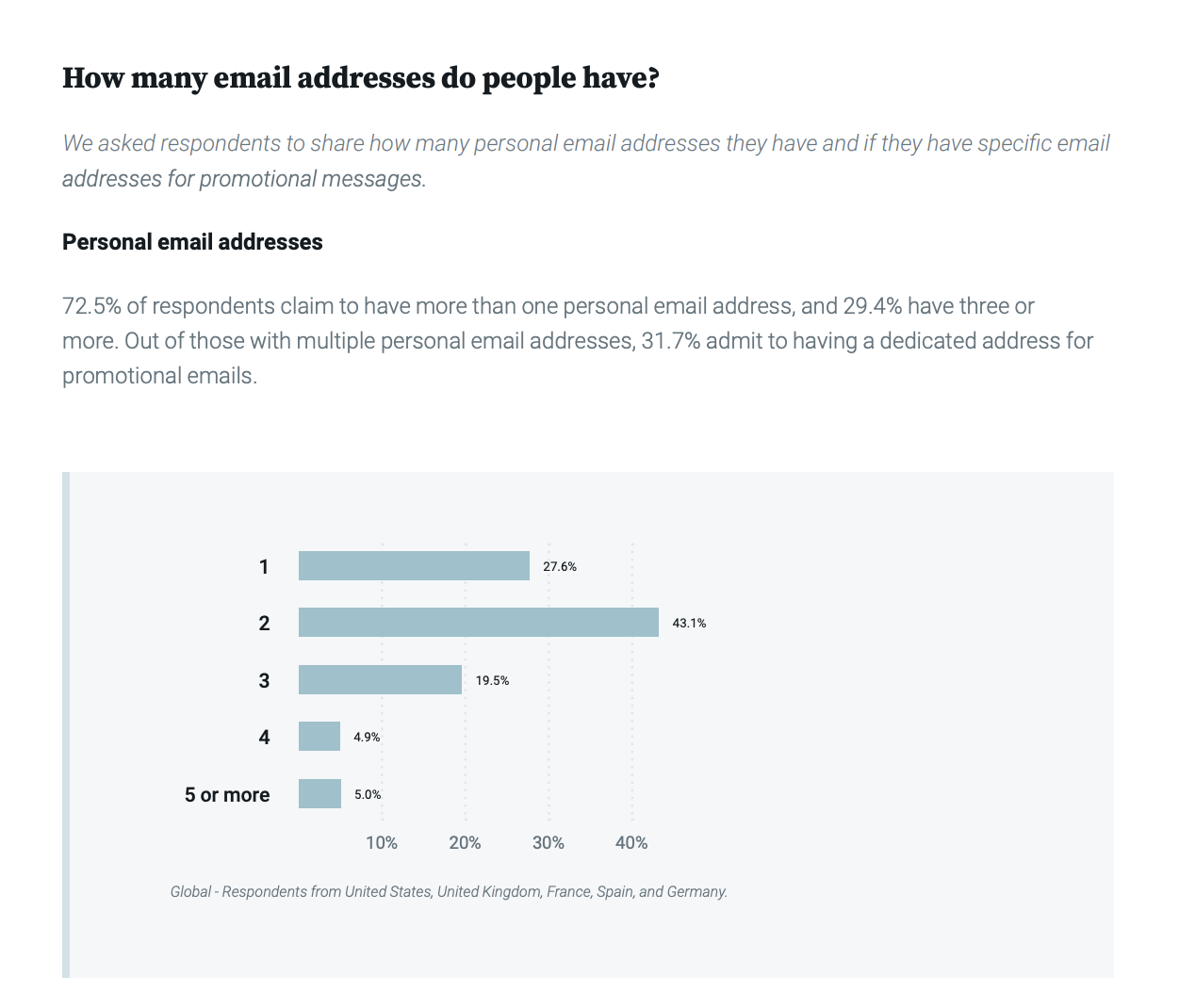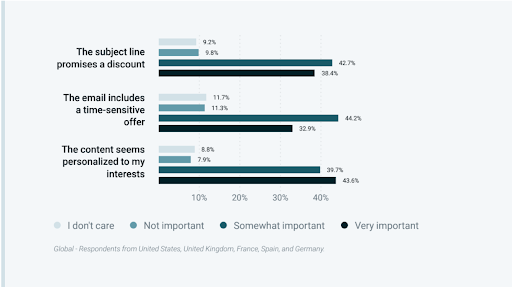Email best practices
The path to email engagement In 2021: Key learnings

Email best practices

You spend hours working on a great Valentine’s Day campaign, carefully applying some of the things that worked best last year, only to send it and see that what was a hit in 2020 is just not cutting it in 2021. Ever been there?
Consumers’ needs and habits are constantly evolving – this year, probably more than ever – and keeping up with email engagement trends can sometimes feel…exhausting, but there are ways to gain insight and strategic inspiration. Of course, what better way is there to do that than by directly surveying email users around the world? By knowing their trends and preferences, you’ll be able to provide what users need and want most in 2021 and beyond.
At Mailjet by Pathwire, we’ve done just that. Last December, we surveyed 2000 email users to learn how they interact with email and what they value in brand communications. In this post, we’ll focus on the most important email engagement takeaways for 2021 and how you can optimize your email program to its fullest potential, but you can download our email engagement report here to read our full findings.
Ready? Let’s dive in.
Email engagement is a big topic, and the question of “how do people interact with their emails?” can’t be answered in one or two neat lines. In our survey, we stayed aware of this and opted to break this question down into smaller questions to learn what users’ email experiences look like.
First things first. When we’re talking about “personal email addresses”, how many are we talking about?
For most people, the answer to this question isn’t “one.” Our survey found that 72.4% of respondents have at least two email addresses, and 31.7% have dedicated email addresses for promotions. Research data shows that most people have between two and three, which could mean someone could have one or two personal addresses, and an additional one for promotions, discounts, and other general B2C emails.

Gmail or Outlook? Apple Mail or desktop browsers? As most email designers know, these are not just random questions – the answers to these can significantly impact their email development process.
These results were not unexpected: the biggest email clients still reign supreme. 65.3% of respondents use Gmail, making it the most-used email client overall. In the United States, Yahoo! was the most popular second-choice email client, and in Europe, Outlook took the number-two spot. When it came to checking email, mobile apps and devices were still the most popular ways to view messages.
How many times per day do you check your own email? Even if you’re more focused on email sending than receiving, we’re guessing you click-through to your inbox at least a few times a day. And you wouldn’t be alone.
According to our survey, 63% of users check their email more than once a day, and up to 25% do it more than five times a day. Even the spam folder, which one might think could be easily forgotten, gets some frequent attention – 67.5% of users check the spam folder at least once a week, and nearly 40% check it every day.
Over the last few years, senders have been increasingly concerned by Gmail tabs, and avoiding the Promotions tab has become one of their number one goals. However, our study found that nearly half of Gmail users don’t have the tabs feature active on their accounts. Of those that do, 79.7% check the Promotions tab at least once a week, and 51% do it every day.
When it comes to the times people check their email, the findings aren’t very surprising. Most people check their emails at different times throughout the day, which means there’s really not one right time to send your campaigns. Our further 2020 research showed that 15:00 UTC drove the highest engagement rates (opens and clicks), which translates to 11:00 AM American CST and 3:00 PM English GMT, among others. You can see users’ email-checking habits in our chart below.

So, now that you know how people interact with their emails, how do you get them opened?
Our research shows that nearly 20% of Americans receive 50 or more emails per day. With inboxes being so cluttered, how do you get people to sign up to your email lists, open your emails, and convert? There are a few concepts to keep in mind.
People want to hear from brands. Trust us – they told us!
In fact, our research found that 78.5% of people want to hear from their favorite brands at least once a week, while more than half would like even more frequent interactions. Email continues to be one of the preferred communications channels, alongside a brand’s website and its social media channels, so understanding what drives subscribes and unsubscribes is key to providing customers with the messages they seek.
Unsurprisingly, discounts and promo codes are a big incentive for joining a brand’s email list. Over 50% of users subscribe for regular or one-off discounts, and deals and special offers are the most valuable elements in brand emails.

Additionally, users tend to be pretty free with their unsubscribes and spam complaints. 51.7% will unsubscribe from or mark as spam unsolicited emails, so brands need to be cautious of their email sending practices to maintain a healthy list of subscribers. Among the top reasons for unsubscribing are unrecognizable sender names and irrelevant content.
Nearly 20% of Americans get more than 50 emails a day, which means the competition in the inbox is fierce. Understanding how users look at their inbox and what motivates them to open messages is key from brands battling to get their customers’ attention.
Our research found that most users check their inboxes from top to bottom, and 88.7% of users say that recognizing the sender is important when it comes to deciding whether to open an email. Making sure that your audience remembers you is a big factor when it comes to engagement – you want them to be excited, not say, “oh, who?”
Personalized content is another big plus for users when it comes to driving email opens. 43.6% of users said a that a message that suggests that the email content is personalized to their interests is a “very important” factor in determining whether to open it, more than discounts (38.4%) and time-sensitive offers (32.9%).

Are you currently sending discount emails, birthday messages, personalized emails, or abandoned cart reminders? In our research, we asked users how they interacted these campaigns to understand their effectiveness. What do they do with them? Open and delete? Frantically click through to read more or use the promo code?
Most people sign up for brand email lists to get deals and offers, so it’s not shocking to see that nearly 90% of users either save discount emails for later or click through immediately, compared to 75% for personalized emails and 85% for birthday emails. Discounts get attention and, when these are really relevant, they’re most likely to convert new users or sway existing users who are on the fence.
You may be wondering: Is email worth the effort for conversion? What about the rise of instant SMS and its increased capabilities? We also wondered, which is why we asked users whether they preferred SMS to email communications. You can see what they answered in the graph below.

While SMS brand notifications are gaining ground, email remains the preferred communication for all tested types of notifications, including conversion-targeted content like blogs and promotions.
For this reason, it’s a good idea to focus your conversion efforts on email instead of text. Due to its wide adoption and preference, you’re more likely to get new and repeat converts.
OK, so that was all really insightful and interesting, but how can you apply it to your email strategy?
Here’s what you should keep in mind when sending emails this year:
User research can provide excellent insights into what your target audience wants and how you can give it to them – no mess, no fuss, and with the prize of maximum customer interaction. The insights we’ve shared were taken from our comprehensive research report – you can download the full report here to see all of our findings and let us guide you to the next new frontier of email engagement.
Optimizing your email strategy also depends on having the right email partner, and we here at Mailjet by Pathwire think we’re a pretty great fit. At Pathwire, we know email is complicated, and we’re focused on finding ways to make it less so. So don’t worry – we’ll take care of the hard problems, so you can go back to growing your business. For more on Pathwire and our mission, check out our website and see what we’re all about.
Join our newsletter to stay up to date on the latest trends and create amazing, long-lasting relationships for your brand.